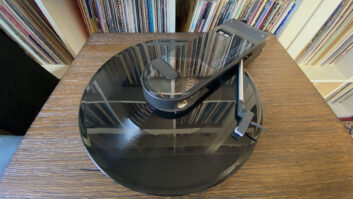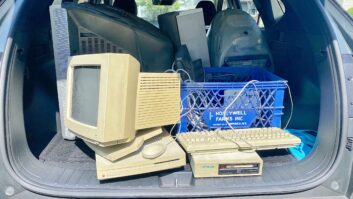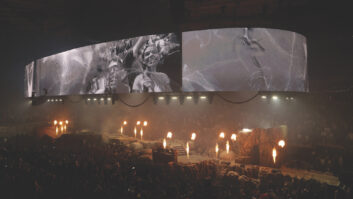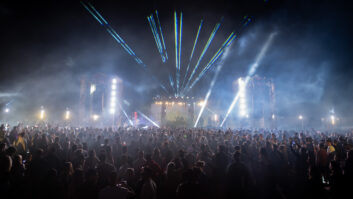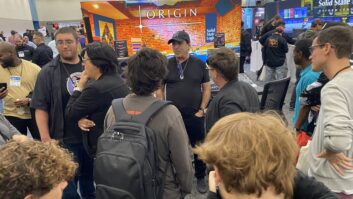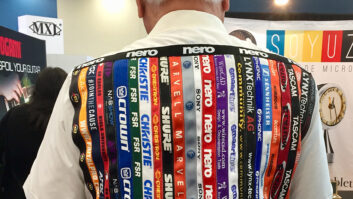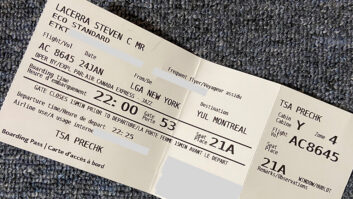Not long ago, I talked to Matthew Girard, a 2000 graduate of the Music Production and Technology program at the Hartt School of the University of Hartford. I asked him what he thought of his past four years. “Oh, it was great,” he replies. “Except they got all of the cool gear right after I left.”
When I told program chairman Scott Metcalfe this story, he laughed. “I hear that from the graduates every year,” he says. “If they didn’t say it, it would mean I’m not doing my job.”
There is plenty of equipment at the Hartt School, and like any good technically oriented school, it keeps changing to keep up with the times. But there is plenty of music training, too, which appeals to me because I’m one of those old-fashioned types who thinks that musicians make the best audio professionals. Engineers who understand scales and harmonies as well as compression and dithering have a much better chance of making it in the audio industry, whether as a mixer, a sound effects editor, a systems designer — you name it. The product of our industry is music — technology is merely the delivery system.
The program at the Hartt School exemplifies this because it combines the idea of audio education based on musical training with a practical approach to real-world recording that is used by a small but growing number of audio programs around the world: Know your music, know your gear, know your fundamentals.
THE BEGINNINGS
The Hartt School used to be known as Hartt College of Music, which has long ranked as one of the top music conservatories in the nation. Founded in 1920, Hartt College merged in 1957 with a liberal arts college and the venerable Hartford Art School to become the University of Hartford. Hartt maintained its own identity within the university and has recently added theater and dance departments, so the “of music” got dropped.
The university’s campus sits on 300 acres of former farmland, about three miles northwest of downtown Hartford, the capitol of Connecticut, a city once described by Mark Twain as “the most beautiful in America.” It’s just about halfway between Boston and New York, a couple of hours’ drive from both cultural centers.
The Music Production and Technology (MPT) program was started in 1994. David Budries, now chair of Theatrical Sound Design at the Yale School of Drama, was the driving force behind it. “The goal was to teach musicians how to be recording engineers and producers,” says Metcalfe. Students who apply to the MPT program must audition on an instrument or their voice, and they take a music theory exam before they are admitted. “We look for musicians with a strong enough background in math and science to handle the electronics and engineering courses,” Metcalfe explains. “Our philosophy is that music should be first and foremost; to be a successful producer, you have to first be a musician and a technician second.”
Metcalfe is a Hartt graduate; he was a music composition major. “I was working as a freelance engineer,” he says, “and I did some theater sound work for David. He recruited me in 1996. I had never taught before, so I thought I’d give it a try. It turns out I really liked it. When David left for Yale, he recommended me as chair.”
WORKING THROUGH THE CURRICULUM
With a rigorous curriculum in place, students have little time to take any more than a handful of electives during the eight semesters. In the first semester, students take a DC electronics course, followed by AC electronics the next semester, then analog circuits, and finally digital circuits. Also required are courses in music theory and analysis, ear training, arts management and acoustics; students are required to take lessons on their instrument (or voice) and participate in one of the school’s many ensembles, as well.
Metcalfe recently added a practicum to the curriculum. He says, “In the past, students helped out in the studios either as volunteers or work/study. But now we’re making it a requirement: at least two hours per week during their sophomore year. They record Hartt concerts, recitals and demos for other students; master performance recordings to CD for duplication and sale; set up P.A. systems for performances; and do archiving, database-ing, invoicing and other business-related duties.”
With a large music school around them, the MPT students develop a wealth of experience in different types of music. “We try to record as many different groups as possible,” says Metcalfe. “The school has a great symphony orchestra, symphonic band, percussion ensembles, a steel drum ensemble and new music groups, as well as the big band and jazz combos. Students also do recordings with rock bands, many of which are made up of Hartt students.”
MIDI courses have been added to the curriculum recently, with an emphasis on Digital Performer, as well as Unity DS-1, Retro AS-1 and Metasynth. “It puts a little more creative, compositional element into the major, which makes them better producers,” Metcalfe says. “We don’t get into beats and loops. We teach them what they need to know about MIDI and synthesis and sampling. And if they want to take it further than that, they can do it on their own.”
In between their junior and senior years, students are required to participate in an internship. The internship requires 150 to 180 hours in a professional facility, and students maintain a daily journal of their experiences. The largest number of students will take on an internship in studios, while some work at theaters, sound reinforcement companies or sound-for-picture facilities.
Seniors take a unit on what Metcalfe considers to be a very important topic: the business of running your own studio. “We talk about insurance, taxes, zoning and getting along with your neighbors,” he says. “A lot of the students are really surprised at how much is involved. Some who were dead-set on having their own place will decide to freelance or work for someone else.”
During their last semester, students are required to produce an album. “We put no stylistic restrictions on it — it just has to be good music that’s well-recorded,” Metcalfe says. “The emphasis at Hartt is on classical and jazz, although, obviously, a lot of the students want to do rock ‘n’ roll. We have had some great recordings come in for senior projects that ranged from rock and jazz to Celtic and classical.”
WELCOME BACK STUDENTS
The MPT program is small — only about 40 students — and it’s competitive: In any given year, about one-third of the program’s applicants are accepted. Most of the students come from the northeast, although other parts of the country are represented, too. Not all of the students who enter each year stay with it. “The biggest loss is between the freshman and sophomore years,” explains Metcalfe. “Some students come in with a Behind the Music understanding of the music business, and they get here and see it’s not all like that. We do a pretty good job of weeding them out at the interview stage, but some get in. Also, sometimes the electronics and math courses will trip them up. So we’ll typically admit 10 or 12 students as freshmen, but by the time they are juniors, there are eight or 10 left. If they decide not to continue with our program, it’s relatively easy for them to go into another major within the Hartt School, since they have all of the theory classes and ensembles from the beginning, or elsewhere in the University of Hartford.”
When they’re finished, students receive a Bachelor of Music. Then what? “We encourage the idea that when they graduate, they can go into business for themselves and open their own small studio,” says Metcalfe. “Our studios are designed more on the ‘project studio’-sized model than the ‘mega-studio’ model. It allows us to have more studios for the students to work in rather than one multi-million-dollar studio that everyone needs to share. It’s also much more likely to be the type of facility they’ll be working in when they graduate. Most of the big studios don’t even have staff engineers anymore. All of our majors are musicians, and many of them are interested in writing and recording their own music, as well as working with other artists.
“A lot of students are inspired by this ‘entrepreneurial’ small-studio model,” he continues. “A few graduates are opening their own studios. Matthew [Girard, quoted at the beginning of the column] is working for Parsons Audio, which is helping him make contacts in the Boston area and allows him to freelance during evenings and weekends. Another grad is a Pro Tools tech at a major sound-for-picture studio in New York. Another is a sound engineer at the Yale Theater. A couple have set up and own commercial facilities, one of which I rent occasionally for sessions. A few go to graduate school. Some will teach their instrument or audio as a sideline while building their audio career. Most are working in audio at some level, even if they consider their current jobs to be just a stepping stone toward their ultimate goal of performing or producing.”
A LOOK AT THE FACILITIES
If you’re looking for the big studio at Hartt, you won’t find it. There’s no 20-foot-long SSL or Trident console or walls full of processing gear or even any 24-track analog decks.
“When David started the program,” says Metcalfe, “he figured he could either pool all of his resources and put together one studio that was really incredible, or he could build several project-type studios. He chose the latter, which makes a lot of sense, considering that’s the part of the industry that’s really growing. That’s the kind of facility where the students are going to be working, either in their own place or someone else’s.”
The studios represent a good cross-section of the modern recording industry. Studio A is centered around a pair of cascaded Yamaha 02R consoles, along with two Tascam DA-88 tape decks, a Tascam MX-2424 hard disk recorder and a Digidesign Pro Tools|24 MIXPlus running on a 450MHz Mac G3. All of the computers in every studio also host Mark of the Unicorn’s Digital Performer audio and MIDI-sequencing software, with a collection of software samplers and synths. In Studio A, there is a rack of Lexicon reverbs, a pair of UREI LA-4s and even an ancient Sound Workshop spring reverb. Built-in monitors are JBL 4430s, and Genelec 1031APs serve the near-field. There are eight channels of Millennia Media mic preamps alongside a healthy mic collection, including everything from Neumann U87s to Shure SM57s, which, of course, can be used in all of the studios.
The studio overlooks Bliss rehearsal hall, the school’s primary practice space for large ensembles. The hall is 58×40 feet with a 19-foot ceiling and architectural features — nonperpendicular and “sawtooth-shaped” walls — that make it an excellent recording space. Audio and video lines tie the rooms together.
Studio B went through the most recent upgrade. It has a Sony DMX-R100 console (which is what Matthew Girard was griping about, because he never got to play with it!) and surround monitoring, thanks to five Mackie HR824s. There’s another pair of DA-88s and another Mac G3 with a Pro Tools|24 MIXPlus system. Studio C is a “bare-bones” room: It has an older Mac with a Pro Tools III system and a pair of Genelec 1031APs. These three studios are tied together with audio, video and Ethernet lines, and Metcalfe is also considering networking the Pro Tools systems with Rorke Fibre Channel.
The computer lab can be found in Studio D, which has five workstations and is also used for theory practice. Each station houses a Mac with Pro Tools, Digital Performer, Finale, and the same MIDI hardware and software as the other studios, as well as music education programs like Music Ace and Practica Musica and a Kurzweil PC88 keyboard. All of the stations are connected to a Mackie 1604 console and a pair of JBL 4412s.
Finally, there’s the booth at Millard Auditorium, a 428-seat performance space with a full orchestra pit that hosts symphonies, chamber music concerts, solo recitals and lectures. A Mackie 2408 console handles the mixing, and there are a Tascam DA-38 tape deck and a CD301 MkII CD recorder, a Panasonic DAT, and a Mac G3 with Pro Tools Project and the usual MIDI suspects. Monitoring is handled by a pair of Mackie HR824s. For important recordings or projects that require more tracks, the Tascam MX-2424 can be brought in.
RELATED PROGRAMS
In addition to the MPT program, the University of Hartford has two other programs that are focused on audio. In the Ward College of Engineering, there’s a Bachelor of Science degree in Audio Engineering Technology, which began around the same time as MPT. It prepares students for the technical and support side of the recording industry. “It’s not a music degree,” explains Metcalfe, “although they do get some music theory and ear training and have the option of some MIDI courses. They get a lot more electronics courses than do MPT students. All of the electronics courses that MPT students take are at Ward, and sound technology courses that the Audio Engineering Technology students take are in our studios.” The Ward College has its own 200-square-foot recording space and a control room equipped with a 24-channel Soundcraft Spirit board, three ADATs and an Ensoniq Paris workstation.
There are also two acoustics programs offered by the College of Engineering — the only undergraduate acoustics programs in the country, according to Metcalfe — that predate the others by a few years. One is a major program in Acoustics and Music: Students receive a Bachelor of Science in Engineering while also enrolled in performance, theory and recording courses at the Hartt School. The other is a concentration in acoustics for mechanical engineering students. The programs train students to design studio spaces, performance venues, loudspeakers and musical instruments, for careers in noise control, environmental acoustics, hearing loss and hearing aid design, and similar fields.
OUT IN THE REAL WORLD
So how does the Music Production and Technology program at the Hartt School prepare students for the real world? Pretty well, according to at least one of its graduates. “When I did my first internship,” says Girard, Class of 2000, “it was in a big studio in Boston with an analog board. When I went in there, I thought, ‘I don’t know a thing about this.’ But then I realized I did know. I was able to take what I had learned and figure things out. I’d never seen this equipment before, but I could take what I knew and apply it. I also knew how to coil cable and take care of equipment, and that was very helpful. And knowing Pro Tools was a real plus — I could help out on that system right away.” Girard is now a Pro Tools specialist at Parsons Audio.
He has high praise for the size and flexibility of the program: “It was a very small group of us, and that was great. We worked together all of the time. The other music students were grateful that we were there because we’d record their concerts or their bands. And at any time of the day or night, you could always find a studio that’s open. The gear might not have been as sophisticated as at some other schools, but the availability was a real plus. I did a lot of recording on my own, not for class, since the studios were open and I had the keys. It gave me a chance to try things out that we weren’t necessarily doing in class.
“The music classes were really important. Just as important as learning how to use the gear and make sounds is understanding what it is you’re recording.”
Any complaints? “What would be great would be to make the program six years [long]. There’s so much to learn. I wouldn’t have minded staying in school an extra couple of years.” This must mean that Hartt is doing something right. After all, when was the last time you heard a young person say that?
Paul Lehrman is back in school again and is somewhat disconcerted that everyone thinks he’s the teacher.
